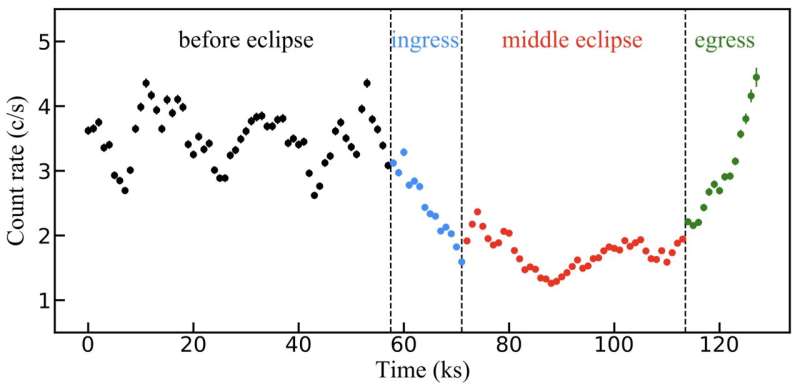
A research team led by Prof. Wang Junxian and Ph.D. students Kang Jialai from University of Science and Technology of China (USTC) of the Chinese Academy of Science (CAS) has revealed a marvelous, composite eclipsing absorber (see the 3D animated diagram below) responsible for a highly distinct X-ray eclipse event in active galaxy NGC 6814. The paper, titled “What can be learnt from a highly informative X-ray occultation event in NGC 6814? A marvelous absorber” was published in Monthly Notices of the Royal Astronomical Society on August 23.
In the nucleus of each large galaxy is a supermassive black hole (SMBH). Some SMBHs are dramatically accreting surrounding materials, emitting powerful radiation across the entire electromagnetic band, known as active galactic nuclei (AGN). AGN ubiquitously produce strong X-ray emissions, believed to originate in a compact region near the central black hole, the so-called corona.
An X-ray eclipse event refers to a scenario where certain obscuring cloud moves across our line of sight, (fully or partially) covering the corona, thus leaving unique features in the observed light curves and spectra. Due to their small size and far distance, neither the corona nor the surrounding cloud could be spatially resolved. However, an X-ray eclipse event, with abundant time-domain information, offers a unique opportunity to depict the event.
Such eclipse events are rare and unpredictable, with less than five full eclipse events with clear ingress/egress periods captured so far. Meanwhile, the interpretation of these events is also challenging, because AGN is intrinsically variable and one can hardly distinguish the intrinsic variation from the variation caused by the eclipsing absorption.
In order to tangle this complexity, the research team for the first time involves the intrinsic “softer-when-brighter” behavior during the analysis of the eclipse event, using flux-color plot to provide extra constraint to the spectral fitting. Applying this technique to the eclipse event in NGC 6814, captured by a high-quality observation of XMM-Newton telescope, the team revealed the existence of Compton-thick absorption, which is invisible in the spectra and thus unnoticed before.
In addition, in the case of NGC 6814, the team found that, to simultaneously explain the observed partial coverage of the absorber, and the long duration of the eclipse but very short ingress/egress, the eclipsing absorber shall be much larger than that of the corona, and clumpy (composed of many small clouds, instead of a single one). Moreover, the team shows the two more layers of absorber with rather small column density detected in the high-resolution RGS spectra are likely the fragments ablated or tidal stretched/disrupted from the main eclipsing absorber, analog to the “comet dust” around comets.
Taken together, the research team depicts the whole picture: the eclipsing absorber is a clumpy, multi-phase cloud cluster (as illustrated by the 3D animated diagram), which might be a part of the disk “wind,” launched from the inner region (The work highlights how X-ray occultation events can promote our understanding of the gas surrounding SMBHs and the unique usefulness of the flux-color plot while analyzing rare X-ray occultation events.
More information:
Jia-Lai Kang et al, What can be learnt from a highly informative X-ray occultation event in NGC 6814? A marvellous absorber, Monthly Notices of the Royal Astronomical Society (2023). DOI: 10.1093/mnras/stad2364
Provided by
University of Science and Technology of China
Citation:
Astronomers reveal eclipsing absorber in active galaxy NGC 6814 (2023, August 28)
retrieved 28 August 2023
from https://phys.org/news/2023-08-astronomers-reveal-eclipsing-absorber-galaxy.html
This document is subject to copyright. Apart from any fair dealing for the purpose of private study or research, no
part may be reproduced without the written permission. The content is provided for information purposes only.
